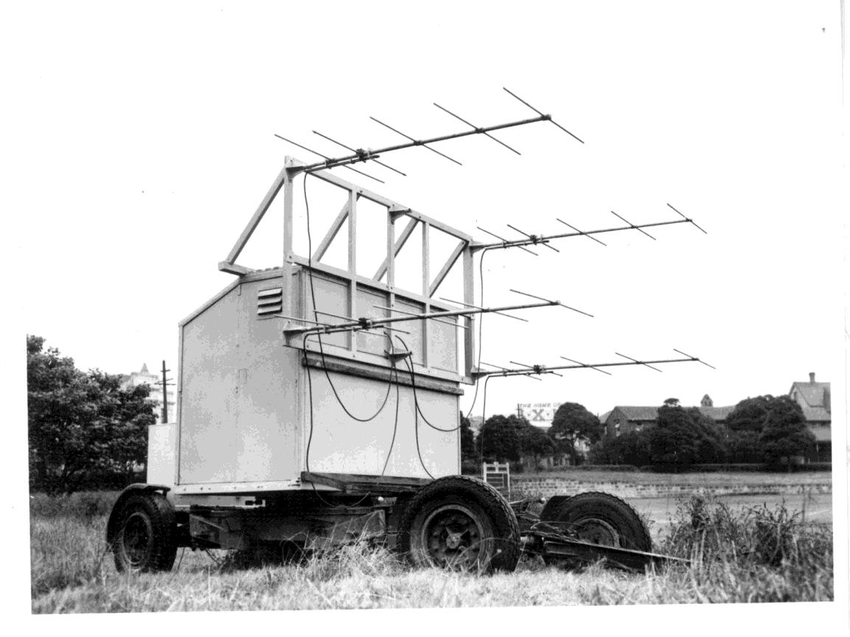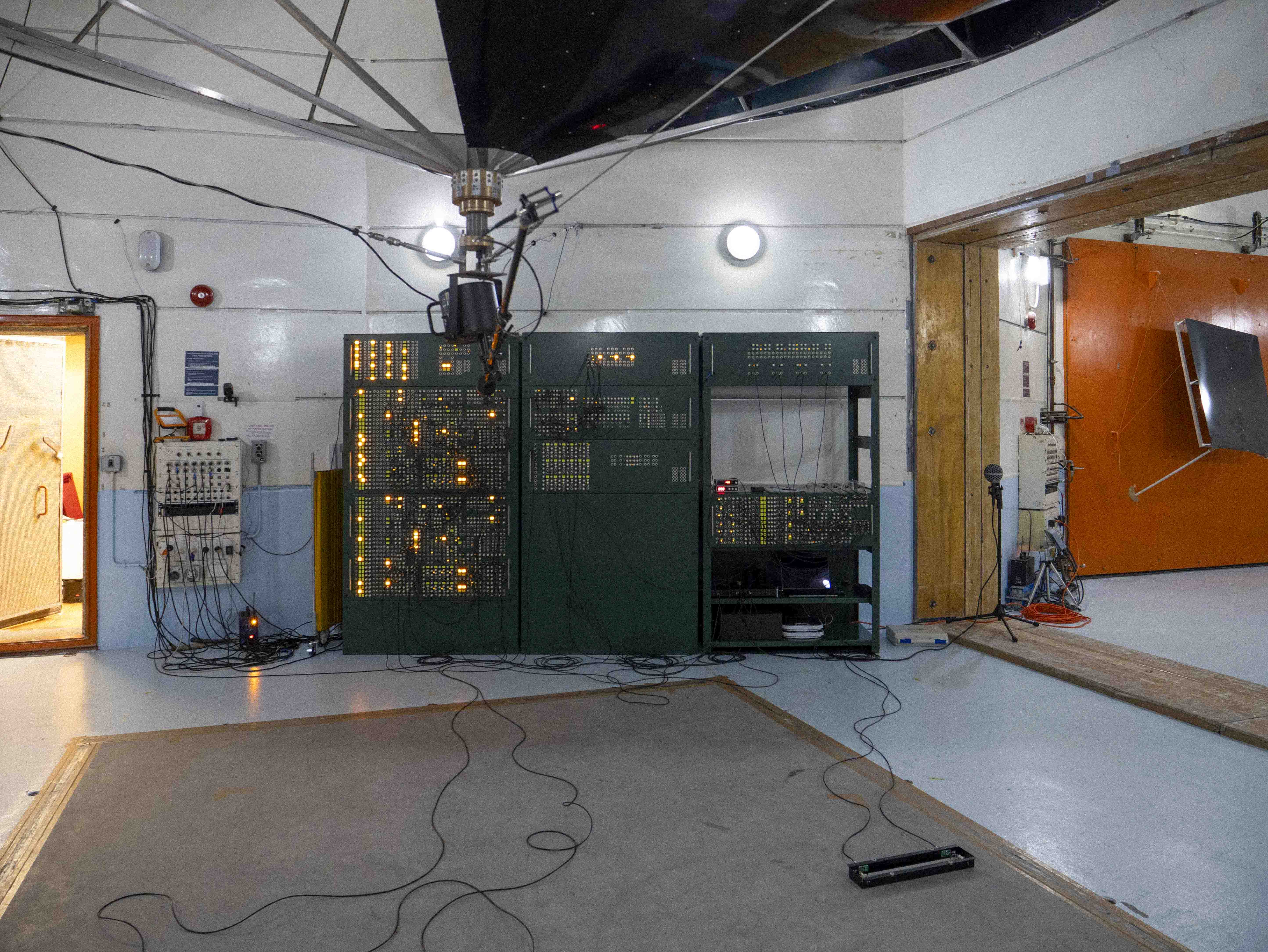The Observatory Project, ASAP, 2025
03-04-25
23-05-25

Electromagnetic radiation (detectable from 500kHz-1.6MHz), LPAM radio wave transmissions, amplitude modulation (AM), portable container site office, Adaptable Sound Interferometry Equipment (A SINE), custom antennae, dipoles, AM loop, balun, transmission line, aluminium, antenna, hardware and fixings, field strength meter, gizmo, noticeboard, notes and notices, carrier waves, sidebands, CRT monitor, video (duration variable), custom printed hi-vis vests, cabling (orange power cords, custom signal cable, antennae feed line), portable radios, galvanised metal workbenches, not-measuring events, whiteboard, clipboards, drawings, measurements, not-measurements, steel mesh (ground plane), plastic mesh chairs, bucket, tape (masking, aluminium, and measuring), alligator clips, UNI-T frequency generators, site office computer, signage.
https://asap.observatory-project.info/

1948 Bolton-Stanley Interferometer
Part of A Time of Waiting at Te Wai Ngutu Kākā Gallery
The Observatory Project, Layne Waerea, John Vea, Public Share, Kalisolaite 'Uhila, Jeremy Leatinu’u, Ena Kosovac, Chris Braddock, Shannon Te Ao, with forthcoming projects by Olivia Webb, Louise Pōtiki Bryant, Luke Shaw and Madison Kelly
Curated by Chris Braddock, John Vea and Stephen Cleland
04 April – 23 May 2025
Project supported by AUT’s Art and Design Research Fund and Creative New Zealand Toi Aotearoa 
The Observatory Project at the Acoustics and Vibration Research Centre
30-11-24
01-12-24

The Acoustics and Vibration Research Centre is comprised of three reverberation chambers and an anechoic chamber used to study acoustics – the field of science associated with the generation, propagation and effects of sound and vibration. Between the 27th November and the 2nd December 2024, The Observatory Project was based at the centre, working in the space to install the Adaptable Sound Interferometry Equipment (A SINE), making towards new sound and video artworks, and conducting research towards our concept of "not-measuring events".
Formed in 2017 after encountering gravitational wave sonification, The Observatory Project is the collaborative research-led project of Eamon Edmundson-Wells and Ziggy Lever that explores making in relation to scientific processes. This project operates at the intersection of art and science, by using sound, video, custom-made electronics, and sculptural installation as a means to diagram, interpret, and imagine scientific processes of observation. To facilitate this research, The Observatory Project designed and built the Adaptable Sound Interferometry Equipment (A SINE), a series of modular sound-generating sculptures that span across perspex-housed devices and large steel cabinets. Recent research includes sea-cliff interferometry, ‘not-measuring’, provisional making in observatories and laboratories, and documentation of machine calibrations.
With special thanks to Gian Schmid, Andrew Hall, Yousif Badri, and George Dodd from the Acoustics Testing Laboratory, and to the Audio foundation for supporting this event.
https://observatory-project.info/
https://www.audiofoundation.org.nz/

RELAY | TOI ATAATA VISUAL ARTS
17 AUGUST - 15 SEPTEMBER 2024
Te Uru Waitākere Contemporary Gallery
RELAY is a multi-disciplinary, durational exhibition developed by Toi Ataata Visual Arts students from Auckland University of Technology. Over four weeks, the gallery will operate as a collaborative installation in which projects are created, displayed and enacted. The projects take various forms, including painting, printmaking, sculpture, photography, moving image, and performance. The title ‘RELAY’ references the dynamic structure of the exhibition. Like a relay race, it is divided into four week-long legs. Each Friday, the ‘baton’ is passed on, and some projects come in and out, re-placing or re-orienting the installation. Live activations also occur throughout the exhibition, with the artists making and performing in the space, responding to notions of accumulation, compilation and trace.
There are 31 contributing artists and collaborators in RELAY from AUT Visual Arts, including final year BVA, Masters, PhD students, and Toi Ataata lecturers:
A’aifou Potemani, Amy Potenger, Ana Ter Huurne, Anna Finlayson, Beth Dawson, Cath Thomson, Elisha Oloapu, Emma Beth, Ethan Morais, Greg Thomas, Hana Carpenter, Harriet Graham, Ingrid Boberg, Jeorja Duffy, Joshua Whitaker, Keani Rewha, Margo Dolgova, Mereem Dewerse, Mia Foulds, Monique Redmond, Natasha Munro Hurn, Ngahina Belton-Bodsworth, Nikita Hesketh, Rebecca Lees, Rita Takeuchi, Samantha Cheng, Stella Roper, Te Ra Awatea Kemp, Tess Elliott, Yuji Iwase, Ziggy Lever.
https://www.teuru.org.nz/whats-on/calendar/relay/

The Observatory Project
Non-standard Measures
2024
Masons Screen
30th Jan – 11th March 2024
In Non-standard Measures, members of The Observatory Project use blank tape measures to mark out metric and imperial units of length. In 2023 we visited public standard measures installed in Paris and London in the 18th century. Marking out by hand our own metres, yards, feet, and inches onto blank tape measures, we playfully push against notions of accuracy and standardisation – putting the metre to measure. Recording the street address of the public standard onto the tape, our measurements speak to local systems of measurement rather than any global standard.
The last original standard metre (Metre Étalon) was erected in 1791 in Paris to promote the new definition of the metre as one ten-millionth of an arc from the north pole to the equator (passing through the Paris Meridian). This represented a cultural shift in France from imperial measures decreed by the king to a new system of measurement borne of the Earth itself. During this time, 16 marble shelves were placed in public spaces around Paris to help introduce the concept of the metre to the public. Our project draws on the availability of these standards to the public, who used these objects to cut their own metres to take back into their shops and homes. These shelves were made to hold a single prototype metre bar perfectly, and this bar was used as an international reference until 1960. Today, Metre Etálon is a somewhat hidden marble shelf tucked behind the Jardin du Luxemburg wall. Not so hidden (although equally as ignored by passing tourists) is a nearby replica, a strange cousin made in the 1800s installed higher on a wall next to the Ritz in Pl Vendôme – a high-end shopping quarter.

In London, outside Greenwich Observatory is the Imperial Standard Measures, which follows a similar formula, allowing a prototype yard, foot, and inch to rest in the defined space. These measures are based on the body (whose body?) as opposed to the metre, which is based on the Earth. Before standardisation, many villages had a local foot, yard, and inch that differed slightly from those installed in Greenwich. When re-measuring the yard in preparation for this work (912cm), an elderly man nearby proclaimed, “Oh, you of little faith!” A condition of the Prime Meridian being established in Greenwich in 1884 (instead of Paris) was that the UK adopted the metre and metric system. This shift wouldn’t happen until 1960, and imperial measures are still used in many aspects of life in the UK.
Translating these measures into drawings on blank tape measures highlights the absurdity of these now “international standards” and their highly local beginnings. We are interested in how performing the act of making a measurement requires a specific kind of being present and can open up space for uncertainty and the traces of a hand amongst otherwise rigid and rational standards of measurement.

This project was commisioned by CIRCUIT for the Masons Screen, 2024.
Aerodynamicas
43°29'15.0"S 172°43'29.0"E
Waimairi Beach Ōtautahi, Aotearoa
1pm — Saturday 22 April 2023


Equinox_1:03PM NZST_23-9-22
23rd September - 8th October
ST PAUL St Gallery
Equinox event 1:03pm (NZST) 23rd September
Opening 5pm 23rd September

LYNN MARIE-KIRBY (PDT) -7
JESSIKA KENNY (PDT) -7
AZADEH EMADI (BST) +1
WOLFGANG WEILEDER (BST) +1
DILLWYN SMITH (BST) +1
STEVE DUTTON (BST) +1
FIONA WILLIAMS (AEST) +10
RODNEY CROSS (AEST) +10
CHRIS BRADDOCK + Guests (NZST) +12
BALAMOHAN SHINGADE (NZST) +12
LAYNE WAEREA (NZST) +12
EAMON EDMUNDSON-WELLS (NZST) +12
ZIGGY LEVER (NZST) +12
THE OBSERVATORY PROJECT (NZST) +12
During the Equinox, the plane of Earth's equator passes through the geometric centre of the Sun's disk. In this celestial alignment, the Earth's poles tilt neither toward nor away from the Sun. On the equator, the sun rises exactly due east and sets exactly due west. Only on the Equinox is a 12 hour day and a 12 hour night shared everywhere on Earth. Observing the Equinox is a call to (re)turn one's attention to the exactness of the present and offers a duty to observe our present condition. This exhibition continues a series of conversations that were held during the northward and southward Equinoxes of 2021 and 2022. Participants from all over the world met at these times to discuss notions of time and duration.
The 2022 southward (vernal) Equinox is at 1:03pm (NZST) on Friday the 23rd September.
This project falls on the exact 50-year spring equinox anniversary of Phil Dadson's Earthworks (1971-2) which was documented as the video 'Earthworks' Represents a Temporary Instant in the Continuum of Universal Ebb and Flow.
28th July - 15th September 2022
Document Scales
Enjoy Gallery
Wellington

There is an awkwardness to the way in which a sheet of A4 paper fits inside of a foolscap filing box. 'Foolscap' in the name refers to the foolscap folio, a paper size that is uncommonly used and yet boxes made to its specific measurements are ubiquitous. Though they feel slightly too long for the A4 scale, the foolscap filing box has become standard in the storage of documents, receipts, notes and exchanges.[1]
On a visit to the North Shore Rockhounds, Ron holds a slice of rock up to a cabochon sizing chart. Here a series of holes are used to guide the shaping of the rock into predetermined scales.[2] The guides sit in old ice-cream containers, alongside the home-made tools and collections of the other rockhounds. Slices of rock, ready to be shaped are filed in trays under workbenches.
In the Neues Museum in Berlin, a display of delicate stone tablets and sheets of papyrus slide back and forth from within a series of hidden drawers. Pressing a button on the side of the cabinet labelled "Knowledge: Mathematics and Astronomy", the third drawer from the top slowly moves out and past the camera. After a short time, the drawer retreats, reducing its exposure to sunlight.
[1] The foolscap filing box usually measures 15x10x3.3" (381x254x84mm) and can be found in abundance in offices, archives, and homes.
[2] Cabochons are judged on their conformity to scale, as well as their subjective qualities
Crystal Systems, by Flora Feltham. Exhibition essay for Document Scales, Enjoy, 2022
13th January - 5th February 2022
SNAIL TIME II
Lucy Meyle and Ziggy Lever
Curving over hard and hidden-into, the whorled structure of a snail's shell suggests an infinite deepening of time as it turns inwards again and again in a vertigo spiral. In our writing and research about the snail, we came to think about how texts and images can become tied to one another across time, and how these ties create slippery trails between ideas. This installation proposes to meet the snail in a field of open query, where ideas and thoughts connect indirectly via shimmering trails of meaning that spiral in and out of the installation.







Time-scale
Scheduled between 2pm and 6pm on Sunday 1st August 2021 at the Old Folks Association in Taāmaki Makaurau, The Observatory Project working with the Generally Relative Acoustic Mass Sense Society (GRAMSS) conducted a public observation. Utilising the new Adaptable Sound Interferometry Equipment (A SINE), members of the observatory carried out an experiment seeking to not-measure the effect/affect/no-effect of mass on a field of elastic sound over a 30-40 minute time frame.
Listen to a recording of the event here.

https://observatory-project.info/
Site last updated by co-text:
© Copyright Ziggy Lever 2021